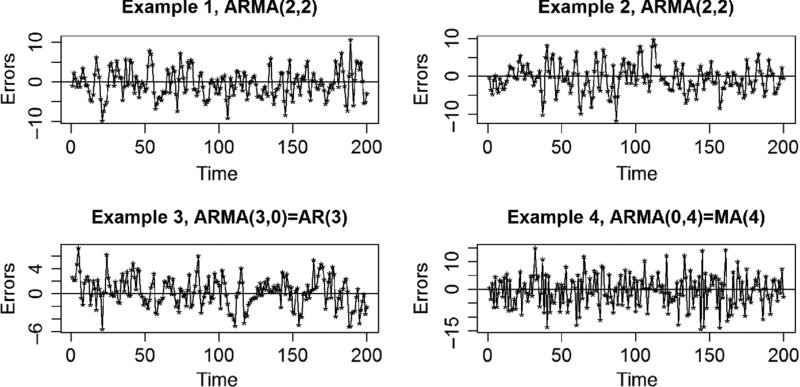14 THE BACKSHIFT OPERATOR, THE IMPULSE RESPONSE FUNCTION, AND GENERAL ARMA MODELS
14.1 THE GENERAL ARMA MODEL
14.1.1 The Mathematical Formulation
Filtering is the key for fitting many useful models, but now generalization from AR(1) to all kinds of AR(m) and/or MA(l) models is required. The general notion of an ARMA(m,l) model is developed.
- The general AR(m) model: ϵj = a1ϵj − 1 + a2ϵj − 2 + ⋅⋅⋅ + amϵj − m + j.
- The general MA(l) model: ϵj = −blwj − l… − b2wj − 2 − b1wj − 2 + wj.
The ARMA(m,l) model: ϵj = ∑ms = 1αsϵj − s + ∑lr = 1 − brwj − r + wj where the white noise components have been combined. A rationale will be developed for arguing that, in practice, all such models can be treated as AR(∞), and approximated by AR(m), for some sufficiently large m.
14.1.2 The arima.sim() Function in R Revisited
The most general ARMA(m,l) models can be simulated in R using the arima.sim() function. For example, consider the ARMA(2,2) model given by ϵn = 0.6ϵn − 1 − 0.25ϵn − 2 + wn − 1.1wn − 1 + 0.28wn − 2. The command to simulate a series of 200 such errors in R, with a standard deviation of 2.0, is arima.sim(n = 200, list(ar =c(0.6, -0.25),ma = c(1.1, -0.28)), sd = 2.0). Notice that the sign convention in R, for the MA(l) part of the function, is the opposite of this book.

FIGURE 14.1 A representative collection of some ARMA(m,l) model errors.
14.1.3 Examples of ARMA(m,l) Models ...
Get Basic Data Analysis for Time Series with R now with the O’Reilly learning platform.
O’Reilly members experience books, live events, courses curated by job role, and more from O’Reilly and nearly 200 top publishers.

